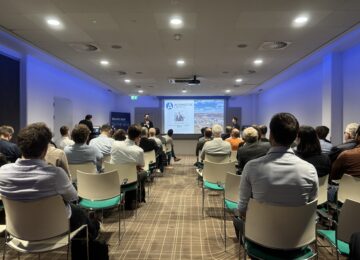Carlijn Lahaye - ENERGYNEST: "Heat storage is an effective, flexible and cost-efficient solution that can be implemented today."
Energy Storage NL begins an interview series with its participants. This time the word: Carlijn Lahaye of ENERGYNEST. In this talk, Carlijn talks about ENERGYNEST's role within the storage sector, the potential of high-temperature heat storage and how they contribute to making industrial processes more sustainable.
Could you briefly talk about ENERGYNEST's role within the energy storage industry? What kinds of things do you guys do?
ENERGYNEST plays an important role in the energy transition by providing innovative solutions for heat storage at high temperature levels, specifically aimed at the process industry. If you look at the total energy consumption in the Netherlands, about 20% of that is for heat in industry. Therefore, to make industry more sustainable, we need to find solutions for industrial heat, and that is exactly what ENERGYNEST focuses on. Our technology enables companies to store sustainably generated energy and use it when needed, reducing their dependence on fossil fuels and reducing their CO2 -emissions. This is especially important because renewable energy sources will not always be sufficiently available, this while the demand for renewable heat will grow. Security of heat supply is therefore essential for many industrial processes. Our heat storage systems not only store excess energy for later use, but also make it possible to reuse waste heat that would otherwise be lost. This contributes to more efficient and sustainable energy consumption.
What form of storage is your technology focused on?
ENERGYNEST focuses specifically on heat storage for the process industry. Our systems are not designed for district heating, but for applications that work with temperatures from 130 to 400 degrees Celsius. Process industries that can benefit from our solutions include food, chemical, refineries, manufacturing, and paper industries. Examples of industries we currently work for include chemical plants, the manufacturing industry, paper mills, energy companies, and refineries.
How does this work? How do you use process heat next?
In the food industry, high-temperature heat is required for sterilization processes. Products must be heated to temperatures above 100 degrees Celsius to kill bacteria and make them safe for consumption. These processes are energy intensive and require constant access to heat. In the chemical industry, heat is used for separation processes that break and convert chemical compounds. These are processes that often take place at high temperatures and require significant amounts of energy.
Traditionally, this energy has been provided by natural gas, the cleanest fossil fuel. However, because burning natural gas results in more CO2 in the air, we want to electrify these processes using clean electricity. Since the availability of renewable energy fluctuates, energy storage is necessary to ensure process continuity. Our systems store electricity during periods of abundance and deliver it when there is a shortage. This allows companies to run their processes continuously on renewable energy.
Could you give an example of an ENERGYNEST project?
A good example of our current initiatives is a project at a paper mill. In this mill's production process, a problem known as paper breakage can occur, leading to loss of product at this mill and blowing off steam from their combined heat and power (CHP) plant. With our solution, this steam can be stored and reused. In addition, the plant currently uses natural gas, but they would also like to electrify. Our technology can solve both problems: reusing waste heat and converting green electricity into heat for later use.
This process not only helps the plant operate more sustainably, but also saves costs. By storing the waste heat that would otherwise be lost, the plant can efficiently reuse this energy. In addition, they can convert green electricity into heat at times when wind and sun are abundant and electricity is more expensive. This makes for more stable, cost-effective and efficient production.
In the specific project at the paper mill, almost half of the savings were in the process. The mill suffers fewer product and time losses because the process runs more stably and energy can be quickly extracted from the heat battery. The other half of the savings came from using stored electricity during low-cost times and providing services to the grid operator, such as Automatic Frequency Restoration Reserve (AFRR). This involves using the heat battery to stabilize the frequency of the power grid. This creates an additional revenue stream for the paper mill.
How much does the installation cost? And when do customers get the payback?
The cost of an installation depends on the specific conditions and applications. Generally, the payback period is between 4 and 9 years. This depends on factors such as temperature of the process heat required, the application, CO2 savings, the ability to participate in the imbalance market, and the specific needs of the company.
For example, a company with a strong focus on CO2 savings will be more likely to invest in our technology, even if the payback period is longer. On the other hand, companies that can benefit from balancing the power grid with our solutions can recoup their investment faster due to the additional revenue from grid stability services.
It is important to emphasize that the benefits of our solutions are not only financial. Reducing CO2 emissions and contributing to a more sustainable environment are important drivers for many companies. Our technology helps companies achieve their sustainability goals.
In what ways do you see the energy market moving? And are you trying to respond to it?
The energy market is volatile and we see a number of important trends and challenges. The trend from Europe is very clear: our energy and production systems will become CO2-free. One recent development is the new administration's announcement to make natural gas cheaper by reducing taxes. This is a step in the wrong direction for sustainability because it reduces the incentive to switch to renewable energy sources. For the energy transition to succeed, the use of fossil fuels must be phased out. Making industry more sustainable is crucial in this regard.
This means providing solutions for industrial heat, such as heat storage, hydrogen and batteries. Our mission at ENERGYNEST is to decarbonize industrial heat. We work daily with industrial parties on solutions that help industry become less dependent on fossil fuels and reduce their carbon emissions.
One of the biggest challenges in the Netherlands today is grid congestion. This means that there is limited capacity to add additional electricity to the grid. This hinders the electrification of industrial processes, as companies need a larger grid connection that is often difficult to obtain. Targets for 2040, where 90% less CO2 is allowed to be emitted, are fast approaching, and industry must prepare accordingly. Fortunately, we see more and more companies and governments becoming aware of the need to become more sustainable, and initiatives are being taken to support this transition through energy storage.
ENERGYNEST is also in other countries. In what do you particularly notice the difference with other countries?
The main difference between the Netherlands and other countries in which ENERGYNEST operates is grid congestion. In countries such as Belgium, northern France and England, this problem is much less of an issue, and various support mechanisms are available to promote the energy transition. In Germany, for example, the heat storage market is much more mature. There we have been active for a longer time, as have other heat storage providers, so there is a better understanding of the benefits and applications of our technology.
In the Netherlands, we often have to explain what high-temperature heat storage is and how it can be applied in industrial processes. The average Dutchman often thinks of batteries when he thinks of energy storage and when he thinks of heat storage he thinks of water or district heating. The concept of high temperature heat storage, specifically for industrial applications, is relatively new and unknown. Our challenge is to make it better known and show how effective and cost-efficient our solutions are.
What are your expectations and projections for ENERGYNEST in the Netherlands?
Although I would like to realize projects in the Netherlands, I expect that my first project will take place in another country. This is because of the challenges such as grid congestion in the Netherlands, but also because some companies prefer proven technologies and want to go through a pilot phase first. However, we are no longer in the phase of small pilot installations, we want to make an immediate impact with large-scale projects.
Our current references help us tremendously. We have an installation at Yara, a well-known name in the Netherlands. Yara sees our ThermalBattery™ as part of their pipeline rather than an installation, making maintenance and inspection easy. The installation saves 12 gigawatt hours of energy annually. References like this are worth their weight in gold, because they show potential customers that our technology is reliable, robust and effective.
Our goal is to complete several large-scale projects in the coming years, both in the Netherlands and in other countries. We have strong leads and are in various stages of negotiation with potential customers. The certainty of subsidies such as the SDE++ in the Netherlands also helps to make projects more attractive to both investors and industry.
What was the motivation for ENERGYNEST to join Energy Storage NL?
ENERGYNEST wants to make high temperature thermal storage better known and sees Energy Storage NL as a powerful network for lobbying and knowledge sharing. When we became a member of ESNL, the heat storage working group had just started, and we saw this as our opportunity to put heat storage for industry on the map. We can only obtain a subsidy such as the SDE++ if we enter into discussions with several parties with the Ministry of Economic Affairs and the government, which is why we also see a lot of value in membership.
We also greatly appreciate the events and initiatives, such as the Energy Storage Event in December and the Energy Trade Fair with the Energy Storage Day. After such events, I still receive months of positive response from people I spoke to there. Now ESNL has also written and handed over the Plan of Action for the further professionalization of the heat sector in the Netherlands. They are all good initiatives, I must say that my expectations have been exceeded.
In what ways do you also benefit from the network, stakeholders and expertise within Energy Storage NL?
In addition to providing valuable contacts within the industry, the network also provides contacts with engineering and consulting firms. By involving consultants in the network and informing them about the different types of energy storage, they can better advise their clients on the appropriate application. Collaborating with consulting firms such as BlueTerra and Royal Haskoning helps to better integrate thermal storage into their advice, which helps us reach new customers.
What do you think is important to show in the article? Do you have a final scolding?
What we want to show is that heat storage in industry is an effective, flexible and cost-efficient solution that can be implemented today. Industrial heat can be made sustainable right now with proven solutions.





